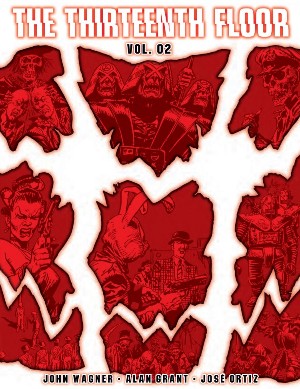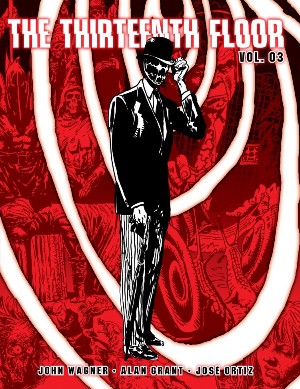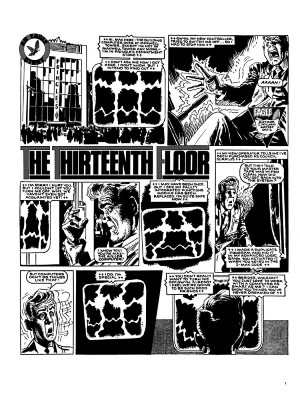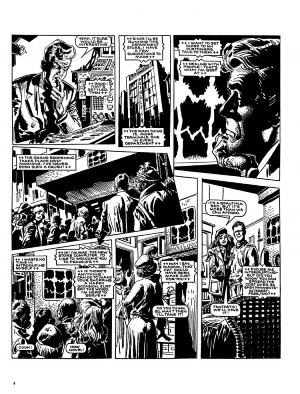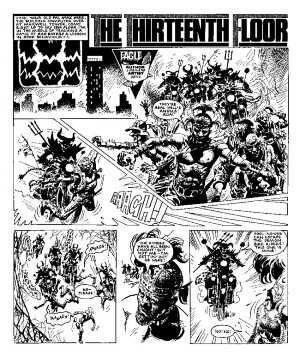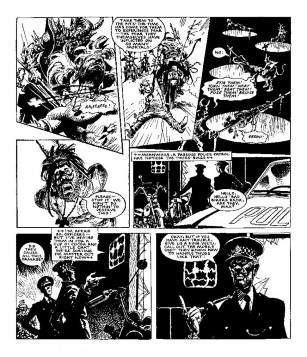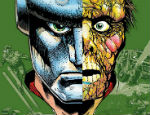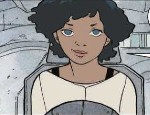Of all the Treasury of British Comics reprint collections to have emerged since publisher Rebellion gained ownership of decades of classic UK comics characters a few years back, few have been as successful in spinning off new content and interest in the original concepts as John Wagner, Alan Grant and Jose Ortiz’s The Thirteenth Floor. Originally a serialised strip in the short-lived early 1980s weekly horror anthology Scream!, the story would survive its parent title’s merger with the second incarnation of Eagle and ran for a long enough time to provide enough content for three volumes of reprinted material from the Treasury over the last few years (you can read our review of the first book here at Broken Frontier).
The Thirteenth Floor’s initial incarnation saw it embracing that reliable standard of horror fiction – the comeuppance story. Set in the ‘80s in residential tower block Maxwell Tower, it originally gave the reader weekly drop-ins to the misadventures of the tower’s experimental artificial intelligence Max, who ran the building. Things went awry when Max subverted his vocational mission and constructed a hidden “thirteenth floor” in the building. There he sent any ne’er-do-wells he believed to be a threat to his beloved residents where they would find themselves in nightmare virtual reality scenarios; ones that fitted their crimes as way of punishment.
So fondly remembered was this serial that the Treasury of British Comics has gone beyond reprinting the entire run across three volumes and produced entirely new stories for the Scream! and Misty Halloween Special and a dedicated The Thirteenth Floor Special. Max himself also played a significant supporting role in Rebellion’s relaunch of many of the old IPC heroes in the pages of The Vigilant. And I would be very surprised if we’ve seen the last of this devious but misguided computer in new material.
That said, the second volume of The Thirteenth Floor collects a run of stories where the strip really does lose its way for a little while. It starts off promisingly enough with Max transferred to Pringles, an Oxford Street department store, where he builds a new thirteenth floor to terrorise unpleasant customers, shoplifters and the like. But this thread is quickly abandoned when he discovers sections of the British security forces are operating in secret in the building and the direction of The Thirteenth Floor changes dramatically. Now an espionage/adventure story rather than strictly a horror one, it sees Max going on spy missions in his alternative MiniMax form.
It’s a shift in premise that is fortunately eventually reversed with Max returning to Maxwell Tower. By the third volume he is firmly established there again and getting back to doing what he does best – meting out poetic justice to those who threaten the security of his block in ever more ghoulish and nightmarish scenarios. It’s all great fun in a darkly comedic way, with Wagner and Grant at their bleakest best. By the end of that third volume, though, it does begin to seem like even they are beginning to see the limitations of the narrative set-up with a recycled storyline about a corrupted Max victimising his own tenants once again being telling in that regard.
Still, there a lot of escapist entertainment value to be had here regardless and it has aged surprisingly well given that it was created at a time when the idea of home computing was in its infancy. Much of that is because when The Thirteenth Floor is at its best it’s a story of human frailties and adopts a strong cast of rich supporting characters. And, of course, Jose Ortiz’s art cannot be over-praised here. His ability to counterpoint the grotesque and fantastic dreamscapes Max creates with the mundane and very recognisable realities of urban life is a key component of The Thirteenth Floor’s success and its long-running, cult following. There’s so much memorable imagery and it’s hardly surprising that among a certain audience of forty to fiftysomethings some of that remains indelibly seared on the brain.
Pick up all three volumes from the Treasury of British Comics online store and (re)discover this classic of British weeklies of yesteryear.
John Wagner and Alan Grant (W), Jose Ortiz (A) • Rebellion/Treasury of British Comics, £14.99 each (paperback)/£19.99 each (hardback)
Review by Andy Oliver





